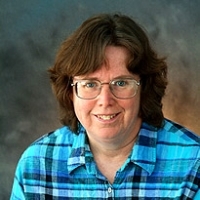Teresa Crease

Professor
College of Biological Science
Department of Integrative Biology
Guelph, Ontario
tcrease@uoguelph.ca
Office:
(519) 824-4120 ext. 52723
Bio/Research
Dr. Crease studies the following topics:
- The genomes of eukaryotes contain many DNA sequences that are repeated hundreds or thousands of times. Such groups of sequences are known as multigene families. It has been observed that sequence similarity among the members of a multigene fami...
Click to Expand >>
- The genomes of eukaryotes contain many DNA sequences that are repeated hundreds or thousands of times. Such groups of sequences are known as multigene families. It has been observed that sequence similarity among the members of a multigene fami...
Click to Expand >>
Bio/Research
Dr. Crease studies the following topics:
- The genomes of eukaryotes contain many DNA sequences that are repeated hundreds or thousands of times. Such groups of sequences are known as multigene families. It has been observed that sequence similarity among the members of a multigene family is high within species relative to the similarity between copies from different species. This phenomenon is known as "concerted evolution".
- Ribosomal DNA (rDNA) is an important multigene family that codes for the structural RNA molecules that make up ribosomes: the site of protein synthesis. One unit of rDNA consists of three genes encoding ribosomal RNA (rRNA) separated by intergenic spacers. The spacers contain sequences that control transcription of the rRNA genes, but they tend to diverge between species very rapidly, as do some regions of the rRNA genes called expansion segments. Despite this rapid evolution, these sequences maintain their function and they evolve in concert.
- Due to variation in the rate of evolution in different parts of the same repeat unit, rDNA is an excellent model system with which to study the interaction between the molecular processes that cause concerted evolution, and natural selection to maintain the structure and function of the molecule. Crease primarily uses freshwater crustaceans in the genus Daphnia as a model organism to study rDNA evolution as they contain unusually long expansion segments, and show variation in the breeding system with some populations reproducing by cyclic and others by obligate parthenogenesis. In addition, a transposable element, Pokey, has been found to insert in a specific region of the rDNA repeat in Daphnia. Moreover, Pokey differs from other rDNA-specific elements in that it is a DNA transposon (the others are non-LTR retrotransposons), and also occupies genomic sites outside of rDNA.
Click to Shrink <<
- The genomes of eukaryotes contain many DNA sequences that are repeated hundreds or thousands of times. Such groups of sequences are known as multigene families. It has been observed that sequence similarity among the members of a multigene family is high within species relative to the similarity between copies from different species. This phenomenon is known as "concerted evolution".
- Ribosomal DNA (rDNA) is an important multigene family that codes for the structural RNA molecules that make up ribosomes: the site of protein synthesis. One unit of rDNA consists of three genes encoding ribosomal RNA (rRNA) separated by intergenic spacers. The spacers contain sequences that control transcription of the rRNA genes, but they tend to diverge between species very rapidly, as do some regions of the rRNA genes called expansion segments. Despite this rapid evolution, these sequences maintain their function and they evolve in concert.
- Due to variation in the rate of evolution in different parts of the same repeat unit, rDNA is an excellent model system with which to study the interaction between the molecular processes that cause concerted evolution, and natural selection to maintain the structure and function of the molecule. Crease primarily uses freshwater crustaceans in the genus Daphnia as a model organism to study rDNA evolution as they contain unusually long expansion segments, and show variation in the breeding system with some populations reproducing by cyclic and others by obligate parthenogenesis. In addition, a transposable element, Pokey, has been found to insert in a specific region of the rDNA repeat in Daphnia. Moreover, Pokey differs from other rDNA-specific elements in that it is a DNA transposon (the others are non-LTR retrotransposons), and also occupies genomic sites outside of rDNA.
Click to Shrink <<